To build muscle with a stationary bike, start by understanding progressive overload. Gradually increase resistance and intensity to challenge your muscles. Focus on engaging your quads, hamstrings, calves, and glutes through proper form and positioning. Incorporate interval training, alternating between high-intensity bursts and recovery periods. Maintain a protein-rich diet to support muscle repair and growth. Ensure sufficient rest and recovery between workouts. Track your progress by monitoring resistance levels, duration, and body composition changes. Remember, consistency is key. By following these steps and adjusting your routine as needed, you'll be on your way to building muscle effectively. Let's explore each step in more detail.
Core Insight
- Engage in progressive overload by gradually increasing resistance and intensity during workouts.
- Incorporate interval training with high-intensity bursts to boost muscle growth and metabolism.
- Target multiple muscle groups by varying bike settings and using proper form.
- Consume adequate protein and nutrients to support muscle repair and growth.
- Allow for sufficient rest and recovery between workouts to promote muscle development.
Understanding Muscle Growth Basics

Building muscle isn't just about lifting weights. Your body can adapt to any form of resistance, like the tension from pedaling a stationary bike. Pushing your muscles past their comfort zone creates small tears in the fibers. As your body fixes these tears, it makes the muscle stronger and bigger. Just like endurance athletes who use mushroom extracts to recover faster and feel less tired, people who use stationary bikes can build more muscle by eating right and taking supplements.
To make your muscles grow, you need to challenge yourself with more resistance or intensity. This is called progressive overload, and it's key for building muscle on a stationary bike. It's also important to give your body the right nutrition and rest. Eating enough protein helps repair and build muscle, while getting good sleep lets your body recover and get stronger.
Targeted Muscle Groups

Stationary bikes work your lower body the most, but they also engage other muscles. Your quads, the big muscles in the front of your thighs, do the main pedaling action. Your hamstrings and calves help push and pull the pedals too. Your glutes, core muscles, and even your upper body also pitch in to keep you stable and balanced as you ride.
Resistance and Intensity Techniques
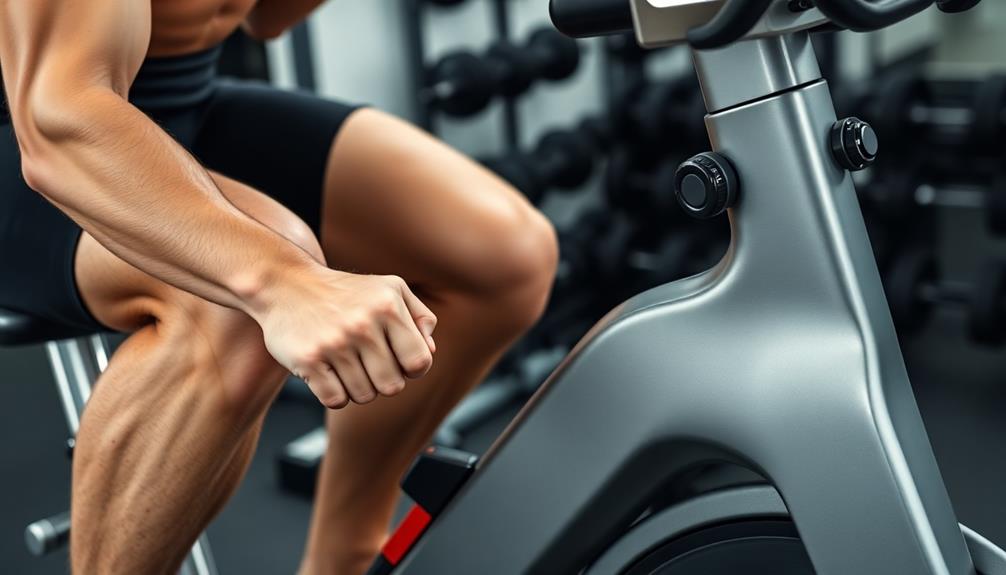
To build muscle on a stationary bike, you need to do more than just pedal. Adding resistance and intensity will help target muscles and make them grow. Try these methods to increase the challenge:
- Slowly increase the resistance level
- Do interval training with short bursts of high intensity
- Stand up while pedaling to use more muscles
- Pedal with one leg at a time for balance and strength
Focus on using good form and engaging your core as you do these techniques. Begin with short, intense workouts and gradually make them longer as you get stronger. Adjust the bike settings to fit your body well for the best muscle engagement. Like resistance tubes, stationary bikes have different resistance levels to fit various fitness goals and progress. Mix up your workouts and keep challenging yourself to see better muscle tone and overall strength. Pair your cycling with a healthy diet and enough rest for the best outcomes.
Proper Form and Positioning
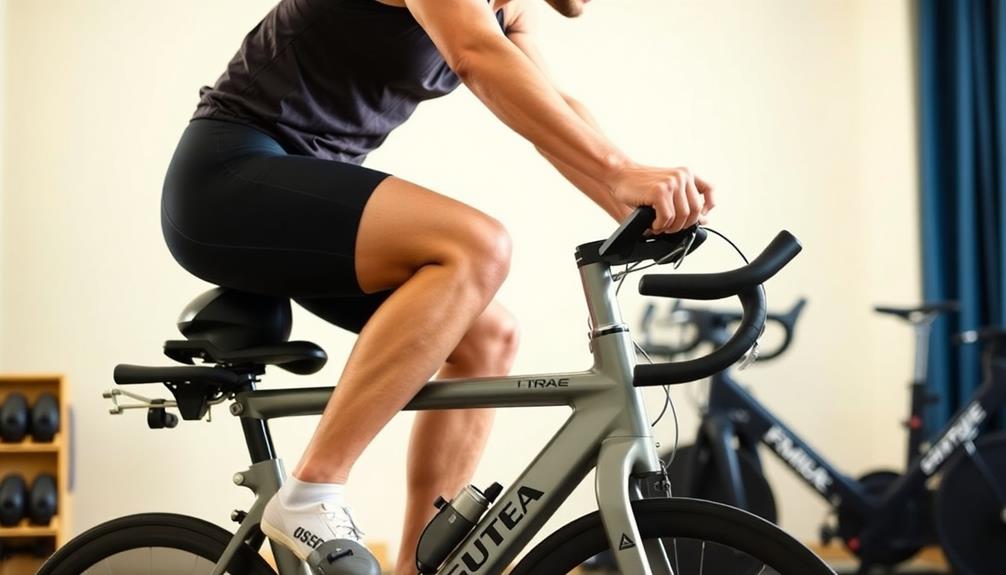
Proper form and positioning on a stationary bike are key for building muscle and avoiding injury. First, adjust the seat height so your knee is slightly bent when the pedal is at its lowest point. Set the handlebars at a height that lets your arms bend slightly when gripping them. Keep your spine in a neutral position, not excessively rounded or arched. Engage your core as you work out to support your lower back. When pedaling, push through your heels to use your glutes and hamstrings. Like finding the right sleeve fit, getting the right positioning on a stationary bike is important for performance and comfort. Avoid bouncing in the saddle; keep your motion smooth and controlled. Your upper body should be fairly still, with a slight forward lean from your hips. Evenly distribute your weight between your sit bones and hands to prevent strain in any one area.
Interval Training for Muscle Building
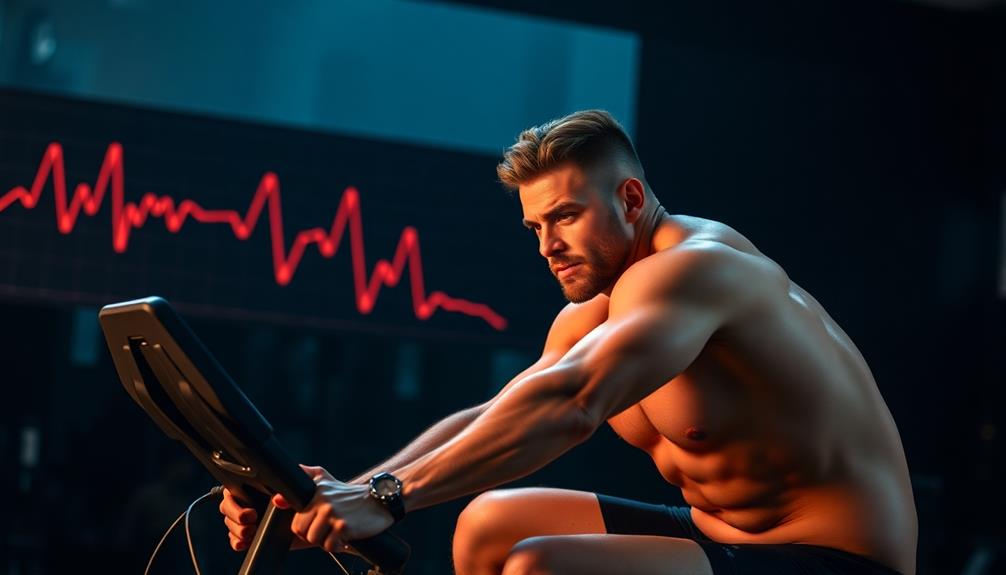
Interval training is a great way to build muscle with your stationary bike. You'll pedal hard for short bursts, then slow down to recover. This challenges your muscles and boosts your metabolism.
Here's how to do it:
- Warm up for 5 minutes at a medium pace
- Pedal as hard as you can for 30 seconds
- Slow down for 60-90 seconds
- Do this 8-10 times
- Cool down for 5 minutes at an easy pace
As you get stronger, you can do more intervals or shorten the rest time. Interval training builds muscle and makes your heart and lungs healthier. Using cold wraps after can help your muscles feel better faster.
Try to do interval training at least two times a week. The more you do it, the better your results will be. Always pay attention to how your body feels. If it's too hard, slow down and work your way up.
Nutrition for Muscle Development
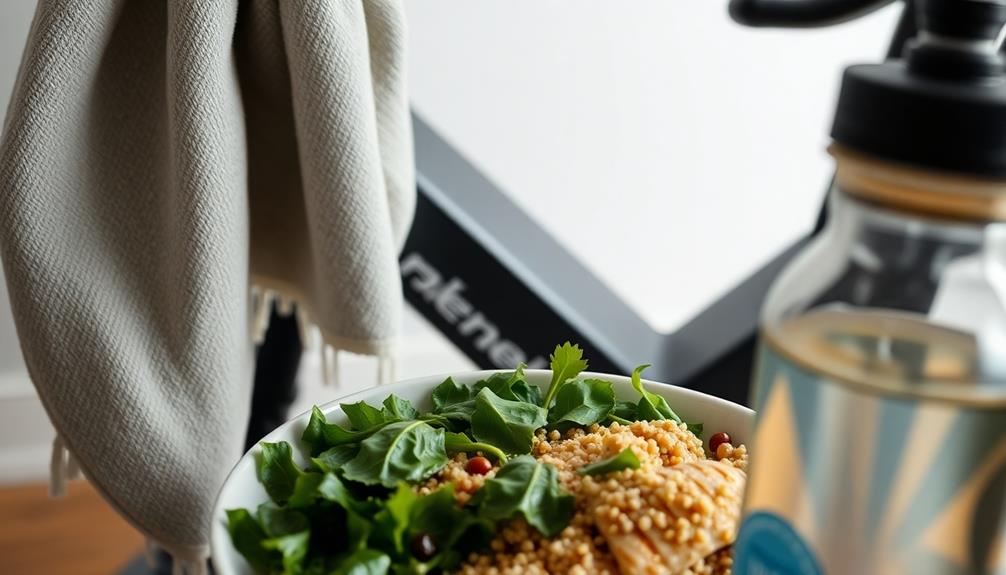
Eating right is key for building muscle when you do interval training. Make sure to get enough protein – about 1.6 to 2.2 grams for every kilogram you weigh. Choose lean meats, fish, eggs, beans, and tofu. Carbs give you energy, so eat complex ones like whole grains, sweet potatoes, and oatmeal. Healthy fats from avocados, nuts, and olive oil are important too.
When you eat matters. Have a meal with protein and carbs within 30 minutes after your bike workout. This helps your muscles recover and grow. Drink plenty of water before, during, and after exercise to stay hydrated and support your muscles.
Recovery and Rest Strategies
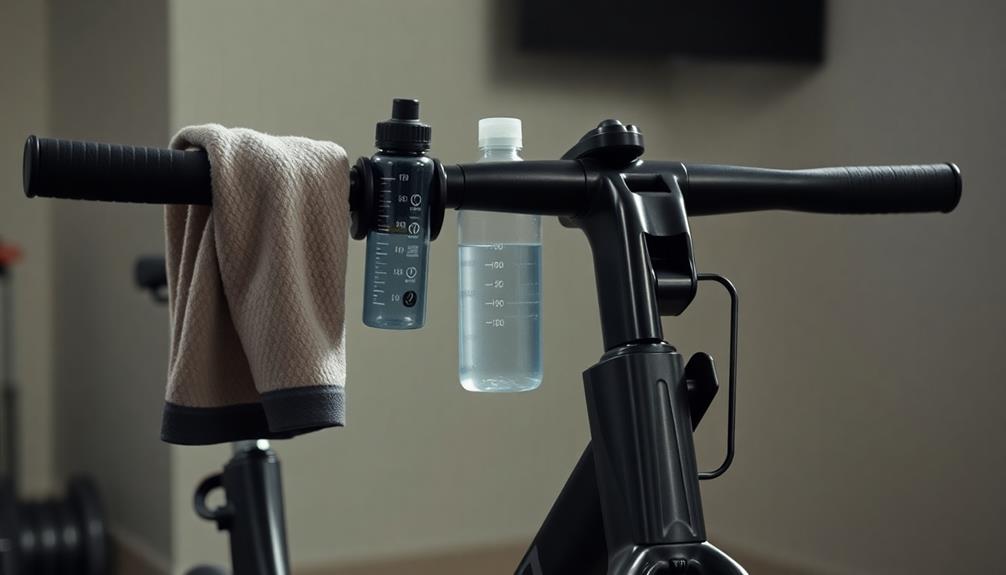
To get the most muscle gains from your stationary bike workouts, recovery and rest are just as important as the exercise itself. Your body needs time to repair and strengthen muscle fibers that have been worked during your rides. Use these strategies to make the most of your recovery:
- Sleep 7-9 hours each night
- Take rest days between hard workouts
- Drink plenty of water throughout the day
- Foam roll or stretch to relax tense muscles
Cooling towels can help cool your body during and after intense cycling. They give cooling relief for up to 3 hours, perfect for recovering after a workout.
Pay attention to your body. Lower your training intensity if you feel very tired. Remember, muscles grow while resting, not during the workout. Light cycling or stretching on rest days can help. This keeps you flexible, gets blood to your muscles to help them repair, and gets you ready for your next hard workout.
Tracking Progress and Adaptation
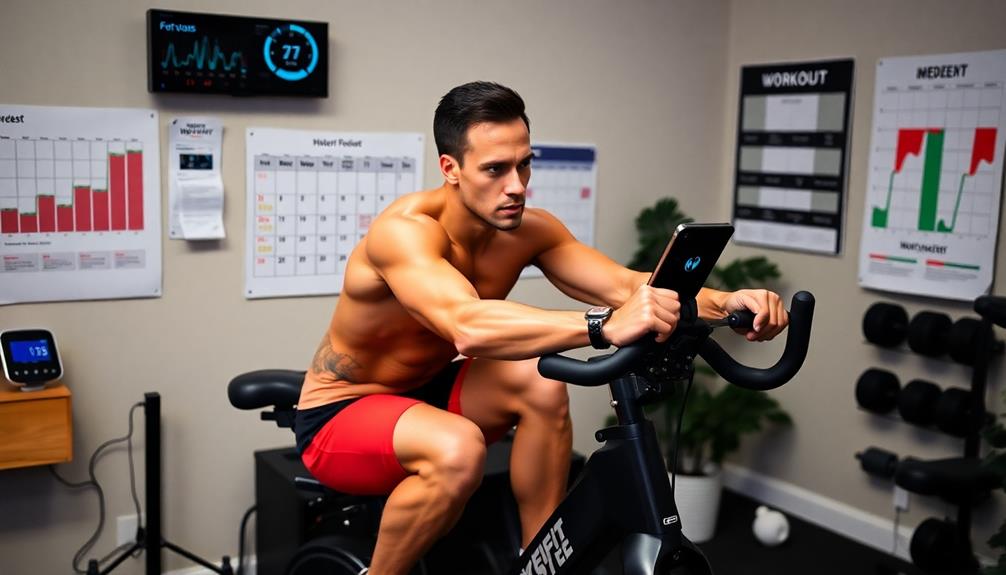
Tracking your progress is key when building muscle on a stationary bike. Write down what you do each session, like the resistance level, how long you ride, and how hard it feels. Every so often, check your body composition and strength to see how you're improving. When you get stronger, bump up the resistance or intensity to keep challenging yourself.
Use this simple table to track your progress:
| Week | Resistance Level | Duration (min) | Calories Burned |
|---|---|---|---|
| 1 | 5 | 30 | 250 |
| 2 | 6 | 35 | 300 |
| 3 | 7 | 40 | 350 |
| 4 | 8 | 45 | 400 |
| 5 | 9 | 50 | 450 |
Tweak your diet and recovery plan as needed to keep up with your harder workouts. Stick with it, even if gains come slowly. Consistency is what matters most for building muscle over time on a stationary bike.
Frequently Asked Questions
Can Stationary Bike Workouts Replace Weight Training for Muscle Building?
No, stationary bike workouts can't fully replace weight training for muscle building. While they can strengthen your legs, you'll miss out on upper body gains and the overall muscle growth potential that resistance training offers.
How Long Does It Take to See Muscle Gains From Cycling?
You'll typically notice muscle gains from cycling within 4-8 weeks of consistent training. However, results vary based on your workout intensity, frequency, diet, and genetics. Remember, visible changes take time, so stay patient and persistent.
Are There Age Limitations for Building Muscle With a Stationary Bike?
You're never too old to build muscle with a stationary bike. While you may see slower gains as you age, consistent cycling can still improve muscle strength and tone at any age. It's always best to consult your doctor first.
Can Stationary Biking Cause Muscle Imbalances in the Lower Body?
Yes, stationary biking can potentially cause muscle imbalances in your lower body. You're primarily working your quads and calves, while neglecting other muscles. It's important to complement your biking with exercises targeting hamstrings, glutes, and hip flexors.
Is It Possible to Build Upper Body Muscle While Using a Stationary Bike?
Yes, you can build upper body muscle while using a stationary bike. Try incorporating dumbbells or resistance bands for arm exercises during your ride. You'll multitask, engaging both upper and lower body muscles simultaneously for a full-body workout.

